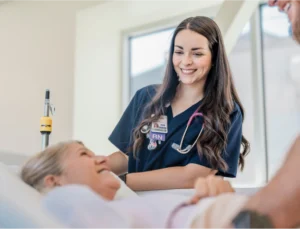 The demand for veterinary technicians is on the rise because veterinarians are relying more on their technicians to assist them, which requires the technicians to have a higher skill level. According to the Bureau of Labor Statistics, the number of job opportunities for veterinary technicians is expected to rise more than 30 percent from 2012 to 2022.1 One particular position that is showing an increase in demand from pet owners is that of a veterinary dental technician. Vet techs who are qualified to perform dental procedures will find more job opportunities at a variety of different places, from clinics to zoos to wildlife centers. Some veterinary hospitals focus primarily on dental care, and the American Society of the Prevention of Cruelty to Animals (ASPCA) is reporting more of a demand for this special type of technician to staff some of their regional locations. Other positions can be found on the American Veterinary Medical Association website.2
The demand for veterinary technicians is on the rise because veterinarians are relying more on their technicians to assist them, which requires the technicians to have a higher skill level. According to the Bureau of Labor Statistics, the number of job opportunities for veterinary technicians is expected to rise more than 30 percent from 2012 to 2022.1 One particular position that is showing an increase in demand from pet owners is that of a veterinary dental technician. Vet techs who are qualified to perform dental procedures will find more job opportunities at a variety of different places, from clinics to zoos to wildlife centers. Some veterinary hospitals focus primarily on dental care, and the American Society of the Prevention of Cruelty to Animals (ASPCA) is reporting more of a demand for this special type of technician to staff some of their regional locations. Other positions can be found on the American Veterinary Medical Association website.2
Oral-health issues affect most pets
Licensure requirements may vary by state, but the need for students to be trained specifically in veterinary dentistry has been reported nationwide. The cost of a visit to a veterinary dental technician is rising, so veterinarians and their assistants are teaching pet owners about the power of prevention. A study reported on by The Seattle Times revealed that approximately 80 percent of dogs and cats over the age of 2 have significant oral health problems. Some of these issues may include gingivitis, periodontal disease, cavities, oral trauma or cysts.1 Veterinarians and technicians often suggest using dental chews or toys, dental diets, brushing or even supplements to keep a pet’s teeth healthy. However, despite a pet owner’s best efforts, some pets will need oral surgery at some point. Often a problem isn’t even noticed until the pet’s owner complains of bad breath. 3 Technicians certified to care for a pet’s teeth become very important at the stage in an animal’s life when its teeth need extensive cleaning or more drastic measures. Dental technicians are responsible for cleaning, administering anesthesia, intubating the animal with an IV when necessary and monitoring the pet’s vital signs during the procedure. Other dental technicians may be trained in using an ultrasound scaler to remove plaque from teeth and examine them for other more serious problems, like when extraction is necessary. For these reasons, more and more veterinarians are seeking out students who are well educated in this field. 2 Owners may put off bringing their pet in for care because they are under the impression they can handle their pet’s bad breath problems on their own, but the risk of harm to the pet and the owner is too great to be ignored. Pets may not sit still while their owner brushes or scrapes their teeth, and that can lead to injury. Also, bad breath is just one symptom that may indicate a more serious problem, like different oral diseases, and X-rays may be needed. 3
Veterinary dental technicians need hands-on experience
Oftentimes students planning to receive their degree in veterinary dental technology are required to perform procedures under the supervision of a veterinarian in a clinic. Some clinics will even accept externs to train in a real-world setting. Veterinarians report their appreciation for some vet tech programs that allow their students to be trained in these clinics because it gives them a chance to create a relationship with that student, and it gives the student the opportunity to see what it is like to meet patients and get to know their owners. That hands-on experience gives students an advantage during their job search.4 The field of veterinary dental technology is growing, and some responsibilities that techs will be required to take on include cleaning and scaling teeth, extracting teeth and performing root canals. Crowns and fillings and providing a comfortable bite for the animal may require surgery, as would tumor removal or fracture repair. Students interested in this field should be prepared for these duties. Another important aspect of this kind of training is the necessity to counsel pet owners in proper dental hygiene practices for their pet at home. Having the ability to maintain a relationship with a pet owner is very important for veterinarians and technicians to not only make the pet feel comfortable, but also establish trust so the owner follows the advice for care. Equipping patients with handouts, answering questions and being able to suggest at-home preventative techniques are all skills students interested in veterinary dental technology should develop.5 1 “Veterinary Technologists and Technicians,” Bureau of Labor Statistics.gov, http://www.bls.gov/ooh/Healthcare/Veterinary-technologists-and-technicians.htm 2“Veterinary Dental Technician Survey and Career Data,” Vet Tech Colleges.com, http://www.vettechcolleges.com/veterinary-technicians/veterinary-dental-technician 3 Pellegrini, Neena, “Veterinary Q&A: Why does it cost so much to clean a dog’s teeth?” Seattle Times.com, April 20,2011, http://seattletimes.com/html/tailsofseattle/2014823207_veterinary_qa_why_does_it_cost_so_much_to_clean_a_dogs_teeth.html 4 Rosinski, S., “Doggy Fresh Breath: Vet Tech Students Practice Dental Procedures on Dogs,” Broadway University.edu, Jan. 8, 2014, http://blogs.broadviewuniversity.edu/2014/01/08/doggy-fresh-breath-vet-tech-students-practice-dental-procedures-on-dogs/ 5 Staff, “What is Veterinary Dentistry?,” Veterinary Dental.com, 2011, http://veterinarydental.com/about/



